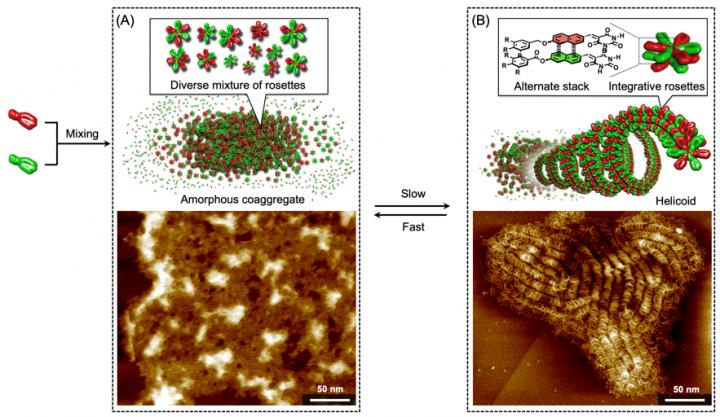
Credit: Shiki Yagai
Researchers in Japan have succeeded in creating a new type of helicoidal supramolecular polymer. The process and mechanism of the generation of its structure were observed using atomic force microscopy (AFM); the helicoidal structure grew spontaneously after two different monomers were mixed. The findings of the study, which was published in Nature Communications on April 1st, 2020 may lead to the design of original soft materials.
In recent years, researchers have paid attention to supramolecular polymers formed through non-covalent bonds with the aim of developing smart soft materials. Shiki Yagai, a professor at Chiba University says, “Supramolecular polymers have various functions. They have self-repair capability and are easily degraded, so through precise design of their molecular structures we will be able to create materials having higher environmental responsiveness.”
For many years, Prof. Yagai and his research team have been working on designing supramolecular polymers that have unique features. Good examples of these new polymers are self-foldable supramolecular polymers and chimera fibers which combine helixes and linear chains.
In this research, the team succeeded in creating a supramolecular polymer whose helicoidal structure extends spontaneously. Extension is started by only mixing two molecules differing in one oxygen atom. By observing its degradation process, they discovered that the new supramolecular polymer has the unique property of changing its chemical structure in response to temperature.
When they mixed two naphthalene molecules, six-membered hydrogen-bonded supramolecular complexes (rosettes) consisting of monomer subunits formed an amorphous coaggregate (Fig. 1-A). However, when left at room temperature, integrated rosette subunits in which two molecules are alternately arranged gradually formed in the mixture, and this spontaneously developed into a beautiful helical structure (Fig.1-B). The team succeeded in controlling the copolymerization using electrostatic interaction between the two molecules, and observed the formation of the helicoid using AFM.
Spectral measurements revealed that this higher-order structural change was due to the composition of the rosette units that make up the polymer. Homopolymers consisting only of electron-rich molecules (red molecules in Fig. 1) are energetically stabilized by forming a stable ring structure, and integrated rosettes are further stabilized by coaggregation. Bonds between the rosettes are strengthened by energetic stabilization and they grow into a helicoidal structure rather than stopping at rings.
In addition, a unique thermal response in which the helicoidal supramolecular copolymers rapidly collapsed at 45 ºC to 50 ºC was discovered. This phenomenon is entirely different from the thermal decomposition behavior of general supramolecular polymers, which gradually disintegrate from the terminal or defect site.
“Using this self-sorting structural change, it should be possible to create new soft materials that quickly respond to various environments,” says Prof. Yagai.
###
Reference:
Aratsu, K. et al. “Supramolecular copolymerization driven by integrative self-sorting of hydrogen-bonded rosettes”, Nature Communications, vol.11, No.1623, 2020, doi: https:/
Contact
Shiki Yagai, Ph.D
Professor
Institute for Global Prominent Research,
Chiba University
Tel: +81-43-290-3169
E-mail: [email protected]
Media Contact:
Midori Ishii
Research Administrator
Station for Academic-Industry Collaborative Research,
Chiba University
Tel: + 81-43-290-2933
Mail: [email protected]
Media Contact
Midori Ishii
[email protected]
Related Journal Article
http://dx.




